О лаборатории
Область научных интересов лаборатории: создание новых материалов, гибридные биоматериалы, золь-гель синтез, катализ, органический синтез, антисептические препараты, нанотехнологии, углеродные наноматериалы, биосенсоры.
Важным направлением работ лаборатории является создание комплексной методологии исследования закономерностей формирования и особенностей свойств кремнийорганических золь-гель матриц и гибридных био– и нанокомпозитных материалов на их основе.
Практическое приложение получаемых в лаборатории новых материалов связано с созданием на их основе сенсорных датчиков, систем биологической очистки и высокоэффективных промышленных катализаторов.
Состав лаборатории
Подробнее о сотрудниках лаборатории можно узнать в разделе Структурные подразделения.
| 1 | Арляпов Вячеслав Алексеевич | Доктор технических наук,
кандидат химических наук, доцент | Заведующий лабораторией |
| 2 | Каманина Ольга Александровна | Кандидат химических наук, доцент | Ведущий научный сотрудник |
| 3 | Соромотин Виталий Николаевич | Кандидат химических наук | Старший научный сотрудник |
| 4 | Фролов Никита Андреевич | Кандидат химических наук | Старший научный сотрудник |
| 5 | Харькова Анна Сергеевна | Кандидат химических наук | Старший научный сотрудник |
| 6 | Кузнецова Любовь Сергеевна | Аспирант каф. Химии | Младший научный сотрудник |
| 7 | Ланцова Елизавета Александровна | Аспирант каф. Биотехнология | Младший научный сотрудник |
| 8 | Медведева Анастасия Сергеевна | Аспирант каф. Химии | Младший научный сотрудник |
| 9 | Перчиков Роман Николаевич | Аспирант каф. Химии | Младший научный сотрудник |
| 10 | Рыбочкин Павел Владимирович | Аспирант каф. Биотехнология | Младший научный сотрудник |
| 11 | Чайка Кристина Даниловна | Магистрант каф. Химии | Младший научный сотрудник |
| 12 | Бардина Маргарита Александровна | Магистрант каф. Химии | Младший научный сотрудник |
| 13 | Белоусова Татьяна Сергеевна | Магистрант каф. Химии | Младший научный сотрудник |
| 14 | Борзова Дарья Владимировна | Магистрант каф. Химии | Младший научный сотрудник |
| 15 | Гуркин Георгий Константинович | Магистрант каф. Химии | Младший научный сотрудник |
| 16 | Лаврова Татьяна Валерьевна | Магистрант каф. Химии | Младший научный сотрудник |
| 17 | Титова Александра Сергеевна | Магистрант каф. Химии | Младший научный сотрудник |
| 18 | Челюканов Максим Сергеевич | Магистрант каф. Химии | Младший научный сотрудник |
Публикации
Список публикаций
| Выходные данные (doi) | Ponamoreva O.N., Kamanina O.A., Alferov V.A., Machulin A.V., Rogova T.V., Arlyapov V.A., Alferov S.V., Suzina N.E., Ivanova E.P. Yeast-based self-organized hybrid bio-silica sol–gels for the design of biosensors // Biosens. Bioelectron. 2015. Vol. 67, № 0. P. 321–326.
ссылка на статью |
| Графический абстракт |  |
| Аннотация | The methylotrophic Pichia angusta VKM Y-2559 and the oleaginous Cryptococcus curvatus VKM Y-3288 yeast cells were immobilized in a bimodal silica-organic sol–gel matrix comprised of tetraethoxysilane (TEOS), the hydrophobic additive methyltriethoxysilane (MTES) and the porogen polyethylene glycol (PEG). Under carefully optimized experimental conditions, employing basic catalysts, yeast cells have become the nucleation centers for a silica-organic capsule assembled around the cells. The dynamic process involved in the formation of the sol–gel matrix has been investigated using optical and scanning electron microscopic techniques. The results demonstrated the influence of the MTES composition on the nature of the encapsulation of the yeast cells, together with the architecture of the three-dimensional (3D) sol–gel biomatrix that forms during the encapsulation process. A silica capsule was found to form around each yeast cell when using 85 vol% MTES. This capsule was found to protect the microorganisms from the harmful effects that result from exposure to heavy metal ions and UV radiation. The encapsulated P. angusta BKM Y-2559 cells were then employed as a biosensing element for the detection of methanol. The P. angusta-based biosensor is characterized by high reproducibility (Sr, 1%) and operational stability, where the biosensor remains viable for up to 28 days. |
| Выходные данные (doi) | Kamanina O.A., Kamanin S.S., Kharkova A.S., Arlyapov V.A. Glucose biosensor based on screen-printed electrode modified with silicone sol--gel conducting matrix containing carbon nanotubes // 3 Biotech. 2019. Vol. 9, № 7. P. 290.
ссылка на статью |
| Графический абстракт | |
| Аннотация | This research shows that high-performance biosensors can be produced by modification of screen-printed electrodes with enzymes and conducting hydrogel based on sol--gel matrix and single-walled carbon nanotubes. Tetraethoxysilane, dimethyldiethoxysilane and polyvinyl alcohol were used as the sol--gel matrix basis. Modified SWCNT provide direct electron transfer during glucose oxidation, as confirmed by cyclic voltammetry. The developed conducting sol--gel screen-printed electrodes can determine glucose within the concentration range 0.045--1.04 mM. The developed biosensor is not only in pace with its world analogues but even exceeds them by some analytical and metrological properties. The developed conducting sol--gel biosensor was used to measure the concentration of glucose in blood. The test results differed only insignificantly from those received with the help of standard glucose meter. |
| Выходные данные (doi) | Lavrova D.G., Kamanina O.A., Machulin A.V., Suzina N.E., Alferov V.A., Ponamoreva O.N. Effect of polyethylene glycol additives on structure, stability, and biocatalytic activity of ormosil sol–gel encapsulated yeast cells // J. Sol-Gel Sci. Technol. Springer New York LLC, 2017. Vol. 88, № 1. P. 1–5.
ссылка на статью |
| Графический абстракт | 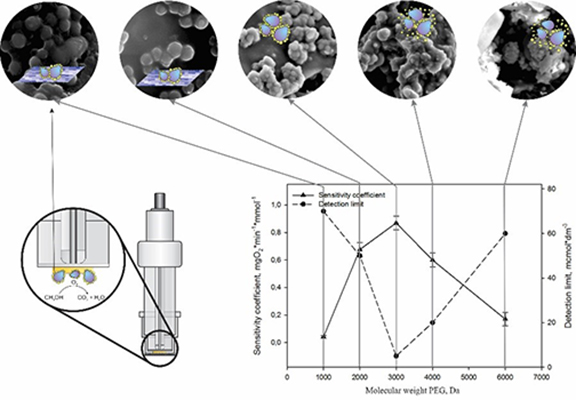 |
| Аннотация | Biohybrid materials based on ormosil encapsulated yeast cells were synthesized through a one-step sol–gel route with base-catalyst (NaF) using tetraethoxysilane (TEOS), methyltriethoxysilane (MTES) and polyethylene glycol (PEG) with different molar weights as a structure-controlling agent. Phase contrast microscopy and scanning electron microscopy were employed to evidence possible structures of the materials. The addition of PEG during cell encapsulation has induced structural changes within the biohybrids, which depend on PEG molecular weights. The biocatalytic activity of the living hybrids has been investigated by a biosensor which was based on the Clark-type oxygen electrode. |
| Выходные данные (doi) | Ponamoreva O.N., Lavrova D.G., Kamanina O.A., Rybochkin P.V., Machulin A.V., Alferov V.A. Biohybrid of methylotrophic yeast and organically modified silica gels from sol-gel chemistry of tetraethoxysilane and dimethyldiethoxysilane // J. Sol-Gel Sci. Technol. 2019. Vol. 92, № 2.
ссылка на статью |
| Графический абстракт | 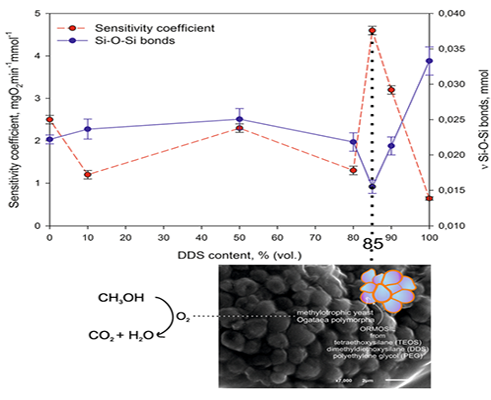 |
| Аннотация | The sol-gel process is an effective method to encapsulate living cells into a three-dimensional silica network under mild conditions. In this work, the structure and properties of biohybrids obtained by immobilizing methylotrophic yeast in a one-step sol--gel synthesis process (pH 7.6) from tetraethoxysilane (TEOS) and dimethyldiethoxysilane (DDS) in the presence of polyethylene glycol (PEG) were investigated. When using DDS organic modifier, gel shells forming around the cells are thinner than those when using MTES. Biohybrid material based on methylotrophic yeast immobilized in organically modified silica (ORMOSIL) gels with TEOS to DDS ratio of 15:85% (vol.), shows the greatest respiration activity during methanol biodegradation. The structure of this material is formed by the smallest number of Si-O-Si-bonds and, therefore, the largest number of free silanol groups. We believe that this creates a comfortable environment for encapsulated microorganisms. This study showed that there was a delicate balance between hydrophilic and hydrophobic components in ORMOSIL matrices for immobilized microorganisms. |
| Выходные данные (doi) | Lavrova D.G., Kamanina O.A., Alferov V.A., Rybochkin P.V., Machulin A.V., Sidorov A.I., Ponamoreva O.N. Impact of hydrophilic polymers in organosilica matrices on structure, stability, and biocatalytic activity of immobilized methylotrophic yeast used as biofilter bed // Enzyme Microb. Technol. 2021. Vol. 150. P. 109879.
ссылка на статью |
| Графический абстракт | 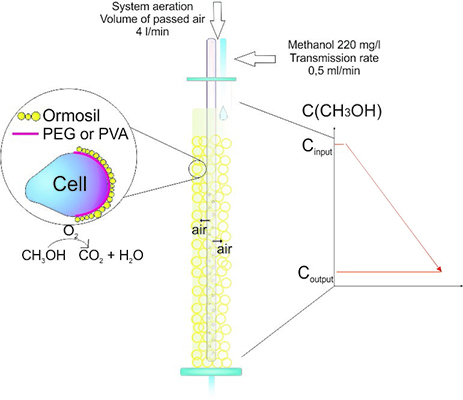 |
| Аннотация | The impact of hydrophilic polymers in an organosilica matrix on the features and performance of immobilized methylotrophic yeast cells used as biocatalysts was investigated and described. Yeast cells were immobilized in a matrix made of tetraethoxysilane (TEOS) and methyltriethoxysilane (MTES) by one-step sol-gel route of synthesis in the presence of polyethylene glycol (PEG) or polyvinyl alcohol (PVA). Organosilica shells were spontaneously built around cells as a result of yeast immobilization at a TEOS to MTES ratio of 85/15 vol% and hydrophilic polymer (PEG or PVA). As a structure-directing agent, PVA produces organosilica films. Stable high-performance biocatalysts active for one year, if stored at −18 °C, have been obtained by entrapment of methylotrophic yeast cells. A trickling biofilter with and without active aeration was designed using entrapped yeast cells to treat methanol polluted wastewater. A biofilter model with active aeration could halve methanol input thus demonstrating better performance compared to treatment without active aeration. |
| Выходные данные (doi) | Zaitseva A.S., Arlyapov V.A., Yudina N.Yu., Alferov S.V., Reshetilov A.N. Use of one- and two-mediator systems for developing a BOD biosensor based on the yeast Debaryomyces hansenii.// Enzyme and Microbial Technology. 2017. V. 98. P. 43-51.
ссылка на статью |
| Графический абстракт |  |
| Аннотация | We investigated the use of one- and two-mediator systems in amperometric BOD biosensors (BOD, biochemical oxygen demand) based on the yeast Debaryomyces hansenii. Screening of nine mediators potentially capable of electron transfer – ferrocene, 1,1_-dimethylferrocene, ferrocenecarboxaldehyde, ferroceneacetonitrile, neutral red, 2,6-dichlorophenolindophenol, thionine, methylene blue and potassium ferricyanide – showed only ferrocene and neutral red to be efficient electron carriers for the eukaryotes studied. Two-mediator systems based on combinations of the investigated compounds were used to increase the efficiency of electron transfer. The developed two-mediator biosensors exceeded their one-mediator analogs by their characteristics. The most preferable two-mediator system for developing a BOD biosensor was a ferrocene–methylene blue combination that ensured a satisfactory long-time stability (43 days), selectivity, sensitivity (the lower limit of the determined BOD5 concentrations, 2.5 mg O2/dm3) and speed (assay time for one sample, not greater than 10 min) of BOD determination. Analysis of water samples showed that the use of a ferrocene–methylene blue twomediator system and the yeast D. hansenii enabled registration of data that highly correlated with the results of the standard method (R = 0.9913). |
| Выходные данные (doi) | Kharkova A.S., Arlyapov V.A., Turovskaya A.D., Shvets V.I., Reshetilov A.N. A mediator microbial biosensor for assaying general toxicity. // Enzyme and Microbial Technology. 2020. V. 132. № 109435.
ссылка на статью |
| Графический абстракт | 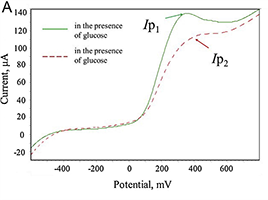 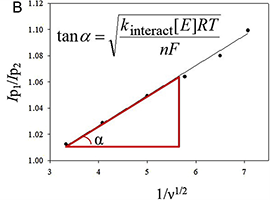 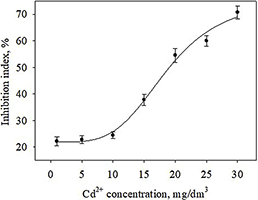 |
| Аннотация | A mediator biosensor based on Paracoccus yeei bacteria for assaying the toxicity of perfumery and cosmetics samples was developed. An approach to selecting an electron-transport mediator based on the heterogeneous electron transfer constants for investigated mediators (ks) and the mediator–biomaterial interaction constants (kinteract) was proposed. Screening of nine compounds as potential mediators showed a ferrocene mediator immobilized in graphite paste to have the highest efficiency of electron transfer to the graphite-paste electrode (the heterogeneous transfer constant, 0.4 ± 0.1 cm/s) and a high constant of interaction with P. yeei (0.023 ± 0.001 dm3/(g·s)). A biosensor for toxicity assessment based on the ferrocene mediator and P. yeei bacteria was formed. The biosensor was tested on samples of four heavy metals (Cu2+, Zn2+, Pb2+, Cd2+) and two phenols (phenol and p-nitrophenol). Proceeding from the EC50 index, it was found that the use of the ferrocene mediator made the biosensor more sensitive to investigated toxicants than most analogues described. Toxicity determination of four perfumery and cosmetics samples by the developed biosensor showed prospects of using this system for real-time toxicity monitoring of samples. |
| Выходные данные (doi) | Arlyapov V.A., Yudina N.Yu., Asulyan L.D., Kamanina O.A., Alferov S.V., Shumsky A.N., Machulin A.V., Alferov V.A., Reshetilov A.N. Registration of BOD using Paracoccus yeei bacteria isolated from activated sludge. // 3 Biotech. 2020. V. 10. I. 5. № 207.
ссылка на статью |
| Графический абстракт | 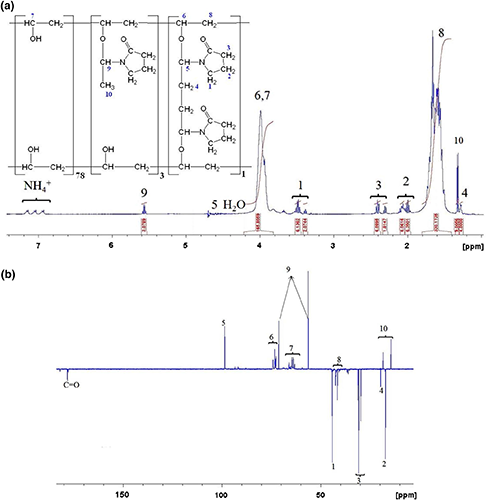 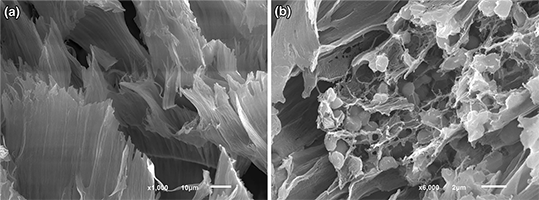 |
| Аннотация | This work investigated the properties of Paracoccus yeei VKM B-3302 bacteria isolated from activated sludge and immobilized in an N-vinylpyrrolidone-modified poly(vinyl alcohol) matrix. The developed hydrogel formed a network structure to enable the entrapment of microbial cells with their viability and biocatalytic properties preserved, which ensured the technological possibility of replicating expendable biosensor receptor elements. A new ratio of the components for the synthesis selected in this work enabled producing a copolymer of an earlier undescribed chemical structure, which can be efficiently used for immobilization of highly sensitive P. yeei bacteria. A biological oxygen demand (BOD) biosensor with these bacteria and matrix was shown to possess a long-time stability exceeding that described earlier, to have a broad substrate specificity and to exceed approximately tenfold the nearest analogues by its sensitivity and the lower boundary value of 0.05 mg/dm3. The biosensor enabled assays of water samples initially attributed to pure samples (the BOD range, 0.05–5.0 mg/dm3). BOD assays of water samples from various sources showed the use of the receptor element of this composition to enable the data that closely correlated with the standard method (R2 = 0.9990). |
| Выходные данные (doi) | Arlyapov V.A., Kharkova A.S., Kurbanaliyeva S.K., Kuznetsova L.S., Machulin A.V., Tarasov S.E., Melnikov P.V., Ponamoreva O.N., Alferov V.A., Reshetilov A.N. Use of biocompatible redox-active polymers based on carbon nanotubes and modified organic matrices for development of a highly sensitive BOD biosensor //Enzyme and Microbial Technology. 2021. V. 143. № 109706.
ссылка на статью |
| Графический абстракт | 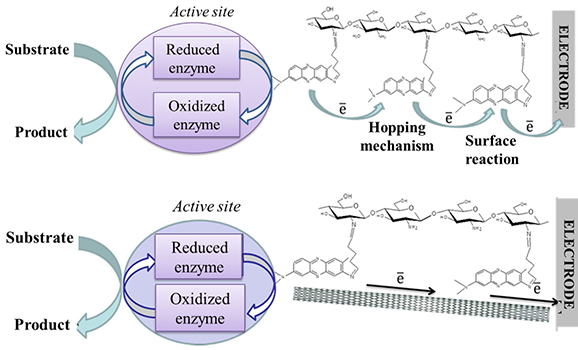 |
| Аннотация | This work investigated the use of redox-active polymers based on bovine serum albumin and chitosan, covalently bound to mediators neutral red and ferrocene and containing carbon nanotubes, for immobilization of Paracoccus yeei VKM B-3302 bacteria. The structures of produced polymers were studied by IR spectroscopy and scanning electron microscopy. Cyclic voltammetry and impedance spectroscopy found the electrochemical characteristics of the investigated systems: the heterogeneous electron transfer rate constant, the constant of the rate of interaction with P. yeei bacteria and the impedance. The systems containing carbon nanotubes and ferrocene-based redox-active polymer proved to be the most promising. Biosensors formed using the hybrid polymers had a high sensitivity with the lower boundary of 0.1 mg/dm3 of the detected BOD5 concentrations and a high correlation (R = 0.9916) with the standard BOD assay of surface water samples. |
| Выходные данные (doi) | Kharkova A.S., Arlyapov V.A., Ilyukhina A.S., Ponamoreva O.N., Alferov V.A., Reshetilov A.N. A kinetic approach to the formation of two-mediator systems for developing microbial biosensors as exemplified by a rapid biochemical oxygen demand assay // 3 Biotech. 2021. V 11, № 222.
ссылка на статью |
| Графический абстракт |  |
| Аннотация | This work proposes a method of forming a microorganism–mediator(s) receptor system, in which the rates of separate stages of mediator bioelectrocatalysis are used as the basis for the development of biosensors for the biochemical oxygen demand (BOD) rapid assay. In the presence of a ferrocene mediator, the yeast Blastobotrys adeninivorans was shown to enable oxidation of a larger range of substrates as compared with other investigated microorganisms—bacteria Escherichia coli and yeast Ogataea polymorpha. The rate constants of the interaction of the yeast B. adeninivorans with nine compounds, electron transfer mediators, were determined; the best mediator for these microorganisms was found to be neutral red (kint = 0.681 ± 0.009 dm3/g s). Neutral red possesses a high rate of interaction with the ferrocene mediator (14,200 ± 100 dm3/ mol s) shown earlier to be the most promising acceptor of electrons at a carbon paste electrode (0.4 ± 0.1 cm/s). These features enabled the formation of a two-mediator ferrocene–neutral red system to be used in a biosensor. A two-mediator-based biosensor had a higher sensitivity (the lower limit of detected BOD concentrations, 0.16 mg/dm3) than that of a one-mediator system based on neutral red and ferrocene. Analysis of ten samples from surface water reservoirs showed the combination of ferrocene, neutral red and the yeast B. adeninivorans to enable the data that highly correlated (R = 0.9693) with those of the standard method. |
| Выходные данные (doi) | Saverina E. A. et al. From Antibacterial to Antibiofilm Targeting: An Emerging Paradigm Shift in the Development of Quaternary Ammonium Compounds (QACs) //ACS Infectious Diseases. – 2023. – Т. 9. – №. 3. – С. 394-422.
ссылка на статью |
| Графический абстракт | 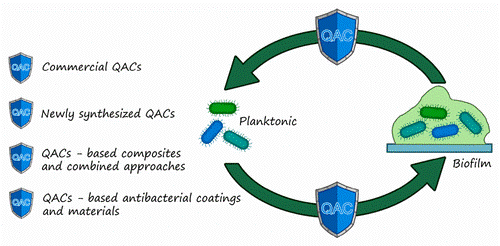 |
| Аннотация | In a previous development stage, mostly individual antibacterial activity was a target in the optimization of biologically active compounds and antiseptic agents. Although this targeting is still valuable, a new trend has appeared since the discovery of superhigh resistance of bacterial cells upon their aggregation into groups. Indeed, it is now well established that the great majority of pathogenic germs are found in the environment as surface-associated microbial communities called biofilms. The protective properties of biofilms and microbial resistance, even to high concentrations of biocides, cause many chronic infections in medical settings and lead to serious economic losses in various areas. A paradigm shift from individual bacterial targeting to also affecting more complex cellular frameworks is taking place and involves multiple strategies for combating biofilms with compounds that are effective at different stages of microbiome formation. Quaternary ammonium compounds (QACs) play a key role in many of these treatments and prophylactic techniques on the basis of both the use of individual antibacterial agents and combination technologies. In this review, we summarize the literature data on the effectiveness of using commercially available and newly synthesized QACs, as well as synergistic treatment techniques based on them. As an important focus, techniques for developing and applying antimicrobial coatings that prevent the formation of biofilms on various surfaces over time are discussed. The information analyzed in this review will be useful to researchers and engineers working in many fields, including the development of a new generation of applied materials; understanding biofilm surface growth; and conducting research in medical, pharmaceutical, and materials sciences. Although regular studies of antibacterial activity are still widely conducted, a promising new trend is also to evaluate antibiofilm activity in a comprehensive study in order to meet the current requirements for the development of highly needed practical applications. |
| Выходные данные (doi) | Kamanina O. A. et al. The Use of Diethoxydimethylsilane as the Basis of a Hybrid Organosilicon Material for the Production of Biosensitive Membranes for Sensory Devices //Membranes. – 2022. – Т. 12. – №. 10. – С. 983.
ссылка на статью |
| Графический абстракт | |
| Аннотация | Biomembranes based on an organosilica sol–gel matrix were used to immobilize bacteria Paracoccus yeei VKM B-3302 as part of a biochemical oxygen demand (BOD) biosensor. Diethoxydimethylsilane (DEDMS) and tetraethoxysilane (TEOS) were used as precursors to create the matrix in a 1:1 volume ratio. The use of scanning electron microscopy (SEM) and the low-temperature nitrogen adsorption method (BET) showed that the sol–gel matrix forms a capsule around microorganisms that does not prevent the exchange of substrates and waste products of bacteria to the cells. The use of DEDMS as part of the matrix made it possible to increase the sensitivity coefficient of the biosensor for determining BOD by two orders of magnitude compared to a biosensor based on methyltriethoxysilane (MTES). Additionally, the long-term stability of the bioreceptor increased to 68 days. The use of such a matrix neutralized the effect of heavy metal ions on the microorganisms’ catalytic activity in the biosensor. The developed biosensor was used to analyze water samples from water sources in the Tula region (Russia). |
| Выходные данные (doi) | Kurbanalieva S. et al. Electroactive biofilms of activated sludge microorganisms on a nanostructured surface as the basis for a highly sensitive biochemical oxygen demand biosensor //Sensors. – 2022. – Т. 22. – №. 16. – С. 6049.
ссылка на статью |
| Графический абстракт |  |
| Аннотация | In a previous development stage, mostly individual antibacterial activity was a target in the optimization of biologically active compounds and antiseptic agents. Although this targeting is still valuable, a new trend has appeared since the discovery of superhigh resistance of bacterial cells upon their aggregation into groups. Indeed, it is now well established that the great majority of pathogenic germs are found in the environment as surface-associated microbial communities called biofilms. The protective properties of biofilms and microbial resistance, even to high concentrations of biocides, cause many chronic infections in medical settings and lead to serious economic losses in various areas. A paradigm shift from individual bacterial targeting to also affecting more complex cellular frameworks is taking place and involves multiple strategies for combating biofilms with compounds that are effective at different stages of microbiome formation. Quaternary ammonium compounds (QACs) play a key role in many of these treatments and prophylactic techniques on the basis of both the use of individual antibacterial agents and combination technologies. In this review, we summarize the literature data on the effectiveness of using commercially available and newly synthesized QACs, as well as synergistic treatment techniques based on them. As an important focus, techniques for developing and applying antimicrobial coatings that prevent the formation of biofilms on various surfaces over time are discussed. The information analyzed in this review will be useful to researchers and engineers working in many fields, including the development of a new generation of applied materials; understanding biofilm surface growth; and conducting research in medical, pharmaceutical, and materials sciences. Although regular studies of antibacterial activity are still widely conducted, a promising new trend is also to evaluate antibiofilm activity in a comprehensive study in order to meet the current requirements for the development of highly needed practical applications. |
| Выходные данные (doi) | Kuznetsova L. S. et al. Development of Nanocomposite Materials Based on Conductive Polymers for Using in Glucose Biosensor //Polymers. – 2022. – Т. 14. – №. 8. – С. 1543.
ссылка на статью |
| Графический абстракт | 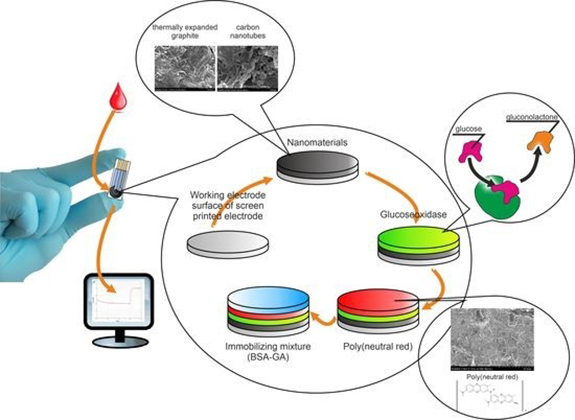 |
| Аннотация | Electropolymerized neutral red, thionine, and aniline were used as part of hybrid nanocomposite conductive polymers, to create an amperometric reagent-less biosensor for glucose determination. The structure of the obtained polymers was studied using infrared (IR) spectroscopy and scanning electron microscopy. Electrochemical characteristics were studied by cyclic voltammetry and impedance spectroscopy. It was shown that, from the point of view of both the rate of electron transfer to the electrode, and the rate of interaction with the active center of glucose oxidase (GOx), the most promising is a new nanocomposite based on poly(neutral red) (pNR) and thermally expanded graphite (TEG). The sensor based on the created nanocomposite material is characterized by a sensitivity of 1000 ± 200 nA × dm3/mmol; the lower limit of the determined glucose concentrations is 0.006 mmol/L. The glucose biosensor based on this nanocomposite was characterized by a high correlation (R2 = 0.9828) with the results of determining the glucose content in human blood using the standard method. Statistical analysis did not reveal any deviations of the results obtained using this biosensor and the reference method. Therefore, the developed biosensor can be used as an alternative to the standard analysis method and as a prototype for creating sensitive and accurate glucometers, as well as biosensors to assess other metabolites. |
Вакансии
- Магистратура и аспирантура:
В лаборатории открывается новый междисциплинарный научный проект. Приглашаем выпускников вузов поступать в магистратуру и аспирантуру ФГБОУ ВО ТулГУ для выполнения актуальных научных исследований и подготовки магистерских и кандидатских диссертаций.
Наша лаборатория приглашает сотрудников для выполнения исследований по актуальным научным направлениям. Продолжительность работы – 1-2 года с возможностью продления и зачисления на постоянную ставку научного сотрудника по результатам работы. Кандидат должен удовлетворять следующим требованиям: наличие ученой степени кандидата наук; наличие публикаций в рейтинговых журналах, индексируемых Web of Science; высокая квалификация и опыт работы. - Научный сотрудник:
При условии успешной работы и достойных научных результатов, предоставляется возможность для участия в конкурсе на занятие постоянной ставки научного сотрудника. В исключительных случаях можно сразу участвовать в конкурсе на ставку научного сотрудника.
Контакты
- адрес: 300012, г. Тула, ул. Ф. Энгельса, 157, ауд. 201;
- телефон: 8(4872)25-24-90;
- электронная почта: basiblab@tsu.tula.ru, basiblab@gmail.com .


